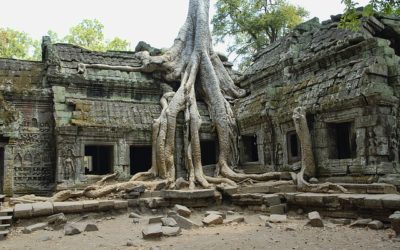 The ancient civilizations of the Indochinese Peninsula form the bedrock from which the modern nations of mainland Southeast Asia would be built. The Angkor Wat of the old Khmer Empire, for example, is such a focal point in Cambodian culture that its iconic temple-mountain structure can be found on its flag, a reminder of a rich legacy that continues into the modern-day. One of our Jewish tours will take us on an exquisite river cruise through Cambodia and Vietnam via the verdant Mekong River. This bountiful waterway continues to provide natural resources for the people of Vietnam, Cambodia, and other mainland Southeast Asian countries, as it has done so for centuries. Indeed, the exotic beauty of nature can be felt while traveling along the Mekong. In a ruined temple near Siem Reap, the splendor of the natural world can be seen intertwined with ancient Khmer architecture. This temple is known as Ta Prohm.
The ancient civilizations of the Indochinese Peninsula form the bedrock from which the modern nations of mainland Southeast Asia would be built. The Angkor Wat of the old Khmer Empire, for example, is such a focal point in Cambodian culture that its iconic temple-mountain structure can be found on its flag, a reminder of a rich legacy that continues into the modern-day. One of our Jewish tours will take us on an exquisite river cruise through Cambodia and Vietnam via the verdant Mekong River. This bountiful waterway continues to provide natural resources for the people of Vietnam, Cambodia, and other mainland Southeast Asian countries, as it has done so for centuries. Indeed, the exotic beauty of nature can be felt while traveling along the Mekong. In a ruined temple near Siem Reap, the splendor of the natural world can be seen intertwined with ancient Khmer architecture. This temple is known as Ta Prohm.
From Angkor
Ta Prohm was established by the influential Khmer monarch Jayavarman VII, whose reign also saw the establishment of Angkor Thom, the last great capital of the Khmer empire. This Buddhist temple and the university was once known as Rajavihara, built in the Bayon architectural style of the structure with the same name in Angkor Thom, which is only a kilometer or so away from this temple. The central image of this temple was Prajnaparamita, an embodiment of the Buddhist concept of wisdom designed to resemble his mother.
From Decline to Modernity
When the kingdom of Angkor lost its influence in the 15th Century, Ta Prohm was but one of the many Khmer monuments that were vacated during the empire’s decline. Like Angkor Wat and Angkor Thom, Ta Prohm was partially reclaimed by the Cambodian jungle. However, neither Angkor Wat nor Angkor Thom was consumed to the same degree as Ta Prohm was, with trees growing into the structures and branches looming over the rubble. The jungle’s reclamation was left undisturbed by the French explorers who “rediscovered” this temple in the early 20th century, choosing to maintain Ta Prohm’s fusion of Khmer architecture and Cambodian flora. Today, this ancient temple is one of Cambodia’s iconic tourist destinations. While looking for Kosher resorts near mainland Southeast Asia, consider planning a visit to this scenic Khmer travel destination.
